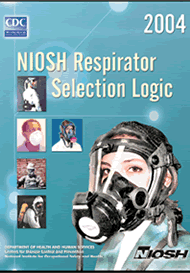Chapter I. Background and
Purpose
The purpose of this respirator selection logic (RSL)
is to provide a process that respirator program administrators can
use to select appropriate respirators for the protection of workers
in specific workplaces. It is not intended to be used for selection
of respirators for protection against infectious agents or chemical,
biological, radiological or nuclear (CBRN) exposures associated with
terrorism events.*
This RSL contains a series of questions regarding situations
which may require the use of respirators. (See Respirator Selection
Logic Sequence, page 5.) In answering these questions, the user of
this selection logic is assisted in identifying specific classes of
respirators, applicable restrictions, and the appropriate respirator
selection table to use. When using one of the tables to identify a
suitable class of respirators, the user must keep in mind the
restrictions identified in the question section of this respirator
selection logic.
This RSL identifies the criteria necessary to determine the
classes of respirators that will provide the minimum acceptable
degree of protection for a chemical at a given concentration.
Classes of respirators offering greater protection can usually be
used in place of the minimum acceptable class of respirators.
Respirator classes are consistent with respirator certification
groupings as specified in 42 CFR 84.
The recommendations in this RSL are based primarily on the
physical, chemical, and toxicologic properties of the contaminant
and on the limitations of each class of respirator, including
filtration efficiency, air supply capability, and face seal
characteristics and leakage. Thus, this selection logic is limited
to identifying classes of acceptable respirators, rather than
individual respirator models.
After various classes of respirators are identified as being
suitable for a given situation, an evaluation is made of other
factors of the particular work environment (e.g., job, task,
temperature, mobility, etc.) so that the most appropriate respirator
model within the recommended classes can be chosen. In some
situations, the selection of a respirator classified as providing a
higher level of protection may be advisable.
The assigned protection factors (APFs) used in this respirator
selection logic were based on quantitative fit factor data developed
by Los Alamos National Laboratories under contract to NIOSH and on
field and laboratory data gathered by NIOSH and others. A Notice of
Proposed Rulemaking on Assigned Protection Factors was published by
OSHA on June 6, 2003. When this regulation is finalized, NIOSH will
consider the new standard and revise the RSL as necessary. NIOSH
will also modify its certification
.* Note: Selection of respirators for infectious disease and
terrorism-related exposures requires consideration of additional
factors in addition to the traditional exposure assessment
approaches described in this guidance. See the NIOSH respirator
topic page http://www.cdc.gov/niosh/topics/respirators/ for
additional information and guidance on particular infectious disease
and terrorism issues.
program to assure that NIOSH
certified respirators will be capable of providing the level of
protection determined in the OSHA APF rulemaking. Fit factors
determined for the individual wearer of a respirator by quantitative
fit testing or by any other method used to determine fit should not
be substituted for the APF given for each class of respirators. In
addition, the fit factor determined through quantitative fit testing
must be greater than the APF (10X the APF is generally recommended);
otherwise, the respirator cannot be used by the worker.
| Note: In order to provide protection at the APF
level, respirators must be used in a complete respirator
program such as the one required by OSHA in
29CFR1910.134. | |
|


